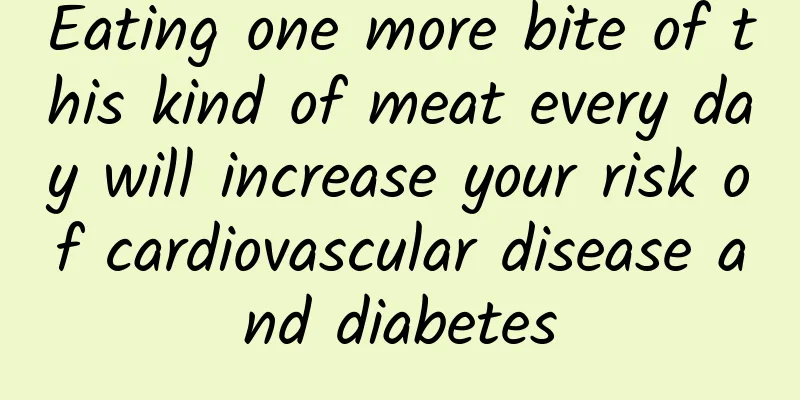Eating one more bite of this kind of meat every day will increase your risk of cardiovascular disease and diabetes

|
We often hear that eating too much red meat and processed meat is bad for human health, including increasing the risk of cardiovascular disease, colorectal cancer, stroke, type 2 diabetes and many other diseases. Some studies even point out that excessive meat consumption may be associated with premature death. So, is eating meat healthy or not? A wide variety of meats Image source: Generated by the author using DALL-E3 According to the definition of the American Foundation for Cancer Research (AICR), "red meat" refers to all kinds of muscles from mammals, such as pork, beef, lamb, horse meat, etc. In contrast, fish and chicken are not classified as "red meat". In commercial sales, there is also a kind of "processed meat", which refers to meat products that have been cured, smoked, fermented or otherwise processed during the production process, such as ham, sausage, bacon, etc. In 2015, the International Agency for Research on Cancer (IARC) under the World Health Organization released a report stating that consuming 50 grams of processed meat products per day can increase the risk of colorectal cancer by 18%. This involves a variety of carcinogenic factors, including iron, N-nitroso compounds, and heterocyclic aromatic amines (such as MeIQx and PhIP) produced during high-temperature cooking. It should be noted that these factors do not absolutely cause cancer, but they do increase the risk. However, it is obviously unscientific to generalize that meat is harmful. There is no conclusive evidence that moderate consumption of red meat causes health problems. Although there are some studies on this topic, their conclusions are often unclear because most studies cannot rule out the influence of other potential confounding factors such as smoking, drinking, and excessive weight. Some studies have pointed out that the risks associated with the type of meat, processing method and intake are relatively small. Gut bacteria may explain Too much red meat is bad for your heart A large number of scientific studies have confirmed that there is a significant correlation between excessive intake of red meat and cardiovascular disease. Generally speaking, this effect is widely attributed to the saturated fat and cholesterol rich in red meat. However, a recent breakthrough study points out that the culprit may not only be these two ingredients, but the intestinal microbiome also plays a key role. Gut bacteria may explain why too much red meat is bad for the heart Image credit: The author used DALL-E3 to generate In a landmark study published in 2022, scientists found a clear link between trimethylamine-N-oxide (TMAO) and red meat intake and the incidence of heart disease and stroke. TMAO is an organic compound produced by certain specific intestinal bacteria when processing choline, phosphatidylcholine and carnitine. It is worth noting that these three nutrients are not only widely present in various animal products, but are also particularly abundant in foods such as red meat and liver. The study further revealed that high levels of TMAO in the body are an important biomarker for determining an individual's risk of heart attack, stroke, and even death. Specifically, participants who ate red meat as their main protein source for one month actually had two to three times more TMAO levels than those who ate white meat or plant-based foods as their main protein source. Don’t panic here. The study also found that there is a positive correlation between red meat intake and the amount of TMAO produced by intestinal bacteria. When red meat intake is reduced, TMAO levels can drop to healthier levels within three to four weeks. In addition, the regularity of lifestyle is also an important factor in determining cardiovascular health, which also provides a basis for studying the connection between TMAO and heart disease risk. This study further confirms that reducing TMAO levels through reasonable dietary intervention is an effective treatment strategy. In fact, we can use the biomarker characteristics of TMAO to design a personalized diet to help individuals determine a more appropriate amount of red meat intake. This gene Linking red meat to cancer The link between excessive red meat intake and a higher risk of cancer has been widely discussed and studied in the medical and nutritional communities. However, the exact mechanism of this link has long puzzled scientists. Recently, a groundbreaking study focusing on the CMAH gene has provided us with more in-depth insights. The CMAH gene is responsible for synthesizing a special sugar molecule called Neu5Gc. This sugar molecule is not only widely found in red meat, but can also be found in some fish and dairy products. Confusingly, the CMAH gene often mutates in the human body, causing our bodies to be unable to produce Neu5Gc on their own. When we eat foods rich in Neu5Gc, since the body cannot produce this sugar molecule on its own, Neu5Gc becomes a "foreign substance." This triggers the body's own immune system, triggering various immune responses against foreign substances. These immune responses can not only cause inflammation and arthritis, but more seriously, they may also act as a medium for cancer. To better understand the distribution of CMAH genes in the animal kingdom, researchers at the University of Nevada, Reno, analyzed 322 different animal genomes and mapped the genome information on an evolutionary map. They found that fish carrying the CMAH gene have relatively low levels of Neu5Gc sugar in their flesh, but caviar has an abnormally high level of Neu5Gc sugar. It turns out that caviar is not only one of the most expensive foods in the world, but also one of the foods with the highest levels of Neu5Gc sugar. The study also found a fish without the CMAH gene, whose caviar should be free of Neu5Gc, providing a relatively safe option for those concerned about cancer risk. In addition to red meat, meat from other animal species that carry the gene may also have similar carcinogenic properties. This discovery raises a question worth further exploring: whether the quality of the meat from these species may also cause other health risks in humans. Protein-rich steak Image source: Generated by the author using DALL-E3 Finally, we have to reiterate that nutritional science is an extremely complex field, and it is inaccurate to simply label red meat as a "cancer nightmare" or a "healthy food". The key is to grasp the principle of "balanced nutrition": on the one hand, ensuring adequate nutritional intake, and on the other hand, taking into account environmental sustainability. A comprehensive and moderate eating habit is beneficial to personal health. According to the "Dietary Guidelines for Chinese Residents (2022)", fish, poultry, eggs and lean meat should be consumed in moderation, an average of 120 to 200 grams per day; it is best to eat 300 to 500 grams of fish, 300 to 350 grams of eggs, and 300 to 500 grams of livestock and poultry meat per week; eat less deeply processed meat products; give priority to fish, and eat less fatty, smoked and pickled meat products. References [1]NotallProcessedMeatsCarryTheSameCancerRisk. [2] Buffa JA, Romano KA, Hazen SL. ThemicrobialgbugeneclusterlinkscardiovasculardiseaseriskassociatedwithredmeatconsumptiontomicrobiotaL-carnitinecatabolism[J].NatureMicrobiology,2022(1):7. [3]SateeshP,AsmitaK,FelixF,etal.PhylogeneticDistributionofCMP-Neu5AcHydroxylase(CMAH),theEnzymeSynthetizingtheProinflammatoryHumanXenoantigenNeu5Gc[J].GenomeBiologyandEvolution2018(1):207-219. [4]Howtogetthenutrientsyouneedwithouteatingasmuchredmeat.UniSAProgramDirectorforNutritionandFoodSciencesDrEvangelineMantzioris. [5]ReynoldsA,MannJ,CummingsJ,etal.Carbohydratequalityandhumanhealth:seriesofsystematicreviewsandmeta-analyses[J].Lancet, 2019. Author: Denovo team Review | Ruan Guangfeng, Deputy Director of Kexin Food and Health Information Exchange Center |
>>: How much do you know about the characteristics of water fitness?
Recommend
What is the cause of brown vaginal discharge and vaginal itching?
Many women have experienced brown vaginal dischar...
Menstruation suddenly came and then stopped
Every girl's menstrual period has its own reg...
What is the cause of leucorrhea like rice soup?
Abnormal changes in women's leucorrhea indica...
Stay away from renal failure and uremia, here are some key tips that early kidney patients must know!
1. Strictly control blood pressure: Hypertension ...
Can I have sex on the fifth day of my period?
Can you have sex on the fifth day of menstruation...
Can I drink black chicken soup during my period? What is the best pot to cook black chicken soup?
Women are usually cold-natured, prone to cold han...
What are the symptoms of vulvar polyps?
There are many kinds of diseases that are easy to...
GSMA: North American Mobile Economy Report 2022
GSMA has released the "2022 North American M...
What are the symptoms of AIDS in women?
When it comes to AIDS, many people will think of ...
If you have this kind of small red rash on your skin in spring, be careful of viral infection
Spring is here, and it's really easy to get s...
Can cervical erosion heal itself?
Cervical erosion is a relatively common female di...
What to do if you have lower abdominal pain after sex
There are many reasons for women's lower abdo...
What is the reason for small fleshy bumps on the vulva?
If women do not pay attention in their daily live...









